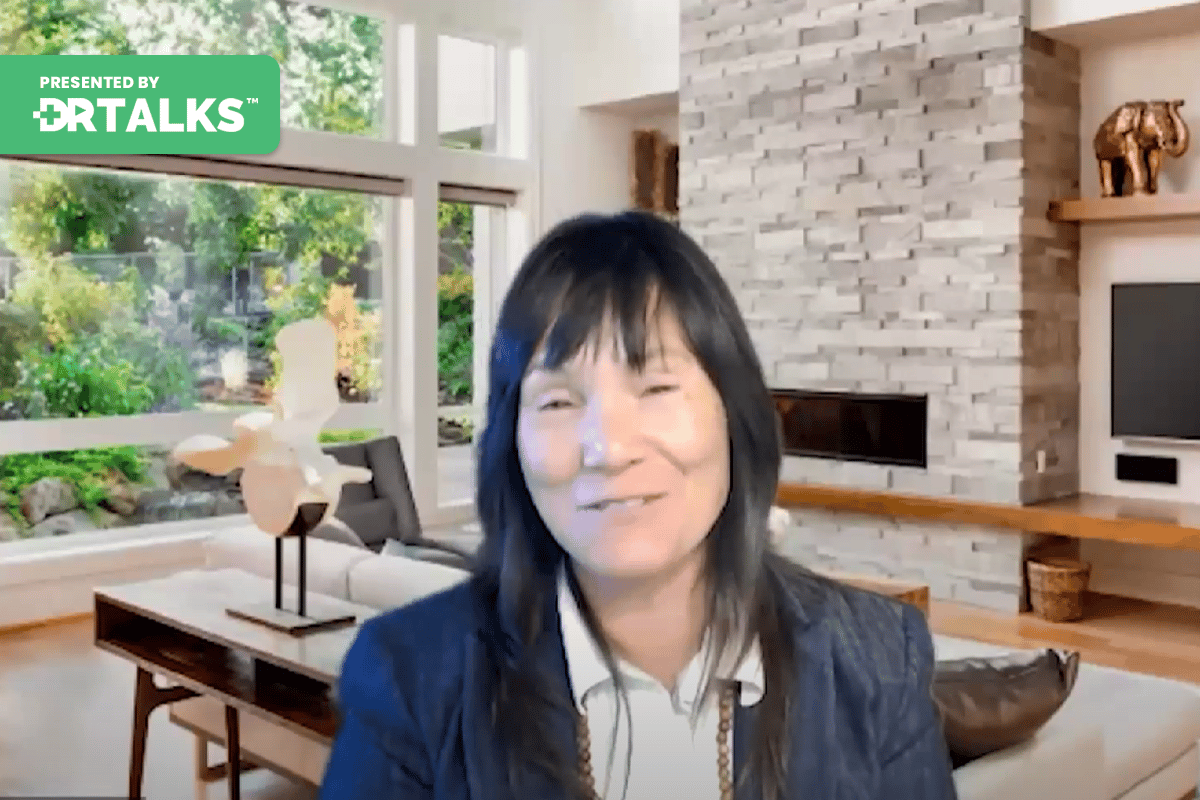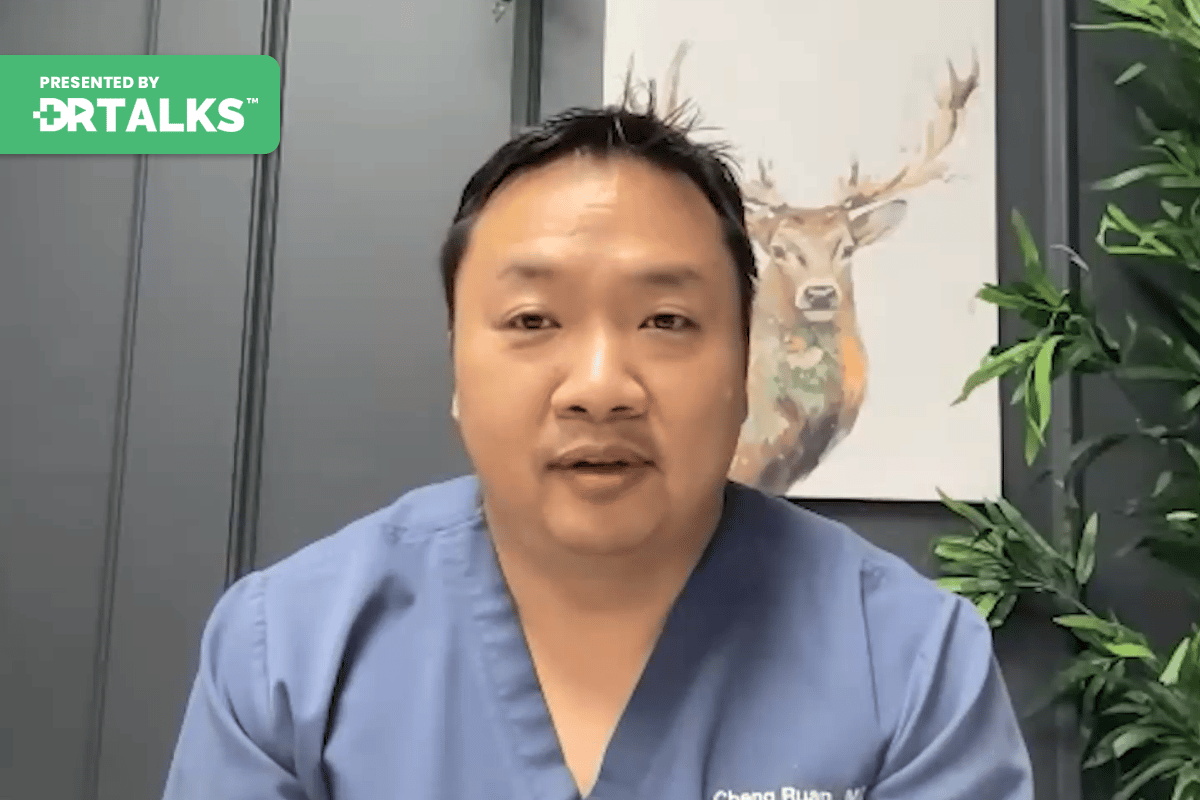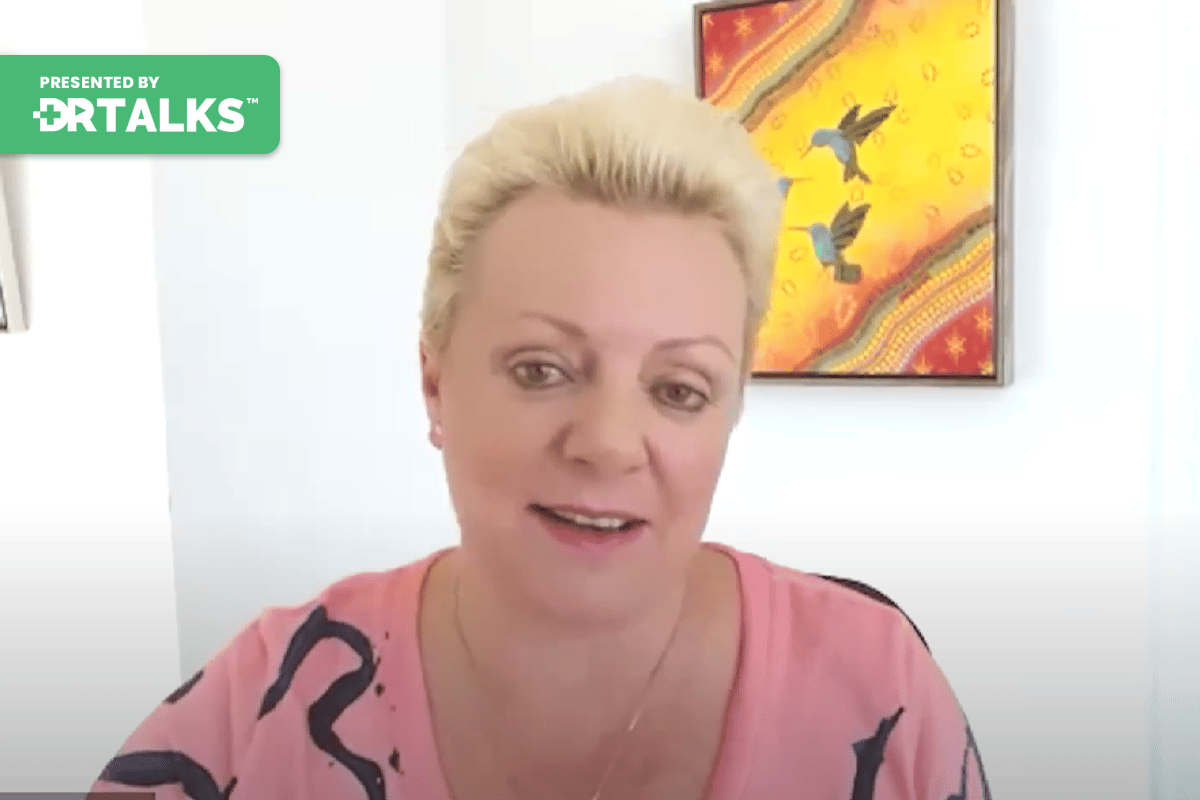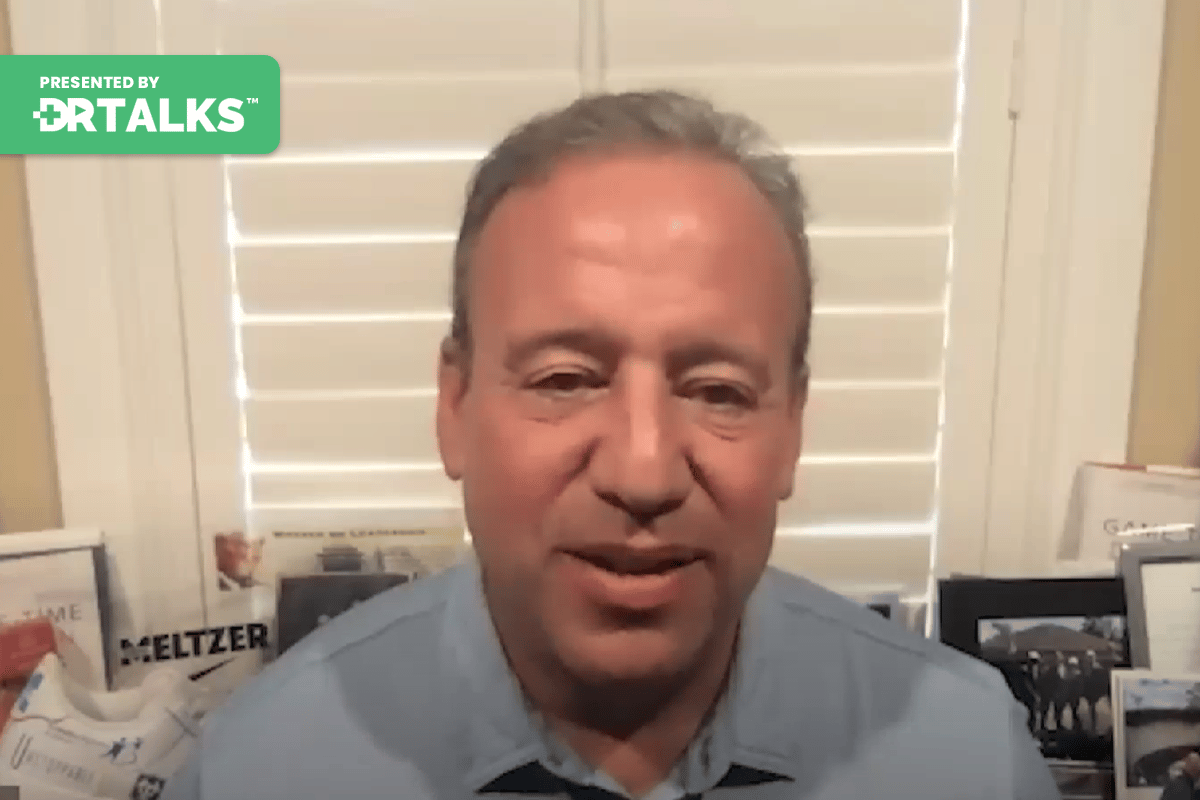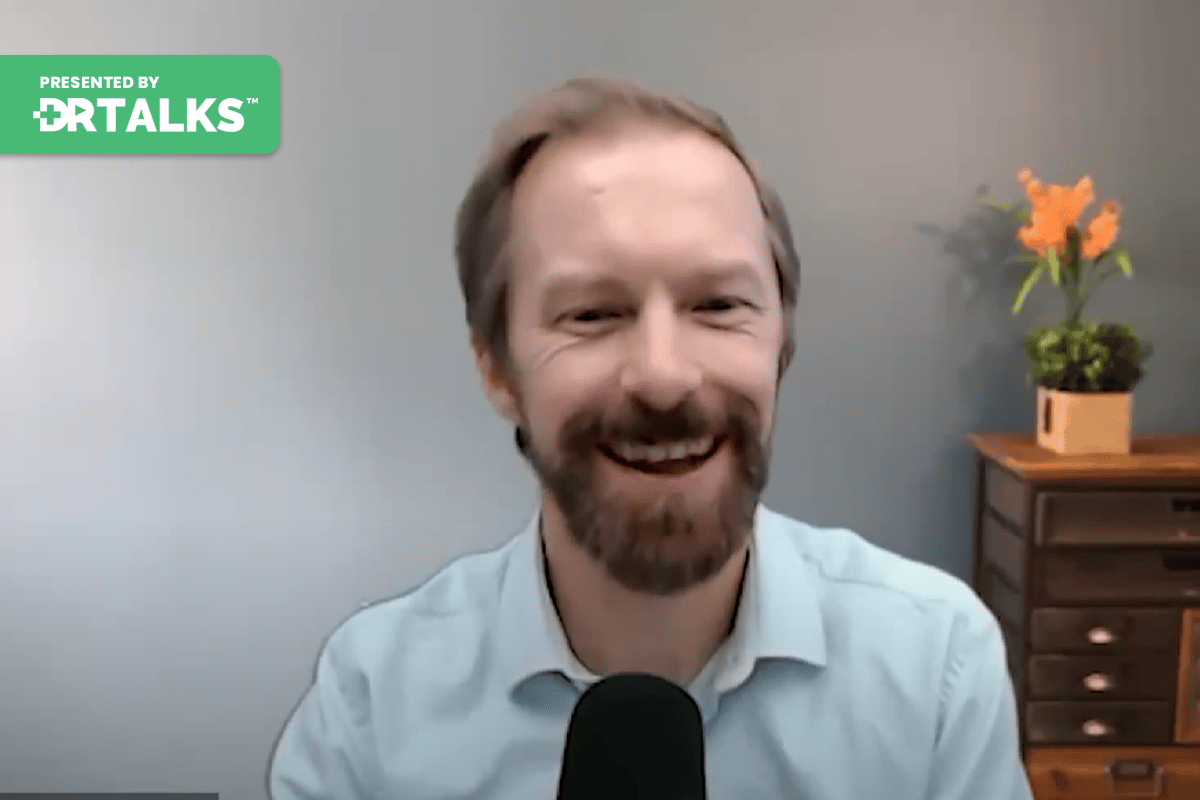Join the discussion below

Tom McCarthy is a husband, father, author, speaker, entrepreneur, and investor who has owned businesses in the training, software, financial services, and restaurant industries. Tom’s clients in his training business include some of the worlds leading companies such as Cisco Systems, Microsoft, Salesforce, Wells Fargo, and MetLife. His latest book,... Read More

Jana Danielson is an award-winning wellness entrepreneur who through her own experience with physical pain turned her mess into her message which has now become her mission. She is an Amazon Best Selling Author, owner of Lead Pilates and Lead Integrated Health Therapies, her bricks & mortar businesses and the... Read More
- Healing does happen from the inside out and it starts with caring for our cells which then supports our body’s systems and functions
- The impact that less than optimal posture, dehydration and a lack of breathing with our diaphragm can make on expediting the aging process
- Joseph Pilates said “Physical fitness is the first requisite of happiness”, I want to help your audience see that the old beliefs of ‘fitness’ and ‘movement’ may no longer serve them and what a viable reframe of wellness could be
- In our bodies (yes. men have pelvic floors too!) we can impact our confidence, our pain, our energy and our sensuality when we learn about the function of our pelvic floor
- Movement is medicine
Tom McCarthy
Alright. My next speaker is somebody that I’m very excited about. We actually just did an interview where she interviewed me and for her amazing summit. And so she was so good and so much fun. I said I’ve got to have her on our Global Energy Healing Summit. Her name is Jana Danielson and she’s an award winning wellness entrepreneur who through her own experiences of being in pain, really was able to turn that pain into an awareness of how to not only heal herself but help so many other people heal. So you’re gonna learn a lot from her. She is a best selling author. She’s the founder of lead Pilates and lead Integrated health therapies and also has something called the Meta District, which is her online health and wellness community. Another thing and she’ll probably talk about this. She is the creator of something called the Cooch Ball. And we’ll have her talk about that a little bit later, but she’s impacted people all over the world, particularly women, 10,000, 10 thousands of more women and she’s gonna impact you two here today. So the title of her talk, I like it is the energy trifecta Pilates posture and the pelvic floor. And so we’re gonna dig into that. But, hey, it’s great to have you on Jana. Thanks for being with us.
Jana Danielson
Thanks Tom. It’s always so great to connect on these platforms because you know that the people that are watching are searching and hopefully, you know, our conversation today will be some little nuggets of information that someone can take today and impact their life.
Tom McCarthy
Absolutely. Well, you’ve helped so many people, I know you’re gonna help a lot more today. So let’s dive right into the trifecta. So, Pilates posture in the pelvic floor, maybe take us through what these three areas are and, and how they became your passion. And let’s start with Pilates. I mean, most people probably know what Pilates is, but for people who don’t know, talk to us a little bit about Pilates.
Jana Danielson
So Joseph Pilates is the, he’s, he was the mastermind behind this whole movement now. And a lot of people don’t realize is that Joseph Pilates who’s not no longer with us on this earth. He was very ill as a child. He had asthma, rickets and rheumatic fever. So his childhood was spent watching others and maybe for some of you that are here on the summit, That’s a similar story to you as well because of that. He loved to watch the way people moved. His mom was a natural path. His dad was a gymnast growing up in the late 1800s in Germany was not your traditional kind of environment for growing up. He learned that movement of the spine was critical to the health of the body and it really is so simple. Pilates, some people confuse it with yoga. There’s lots of similarities, there are some differences. But the one thing that Joe Pilates said that I absolutely love is that physical fitness is the first requisite of happiness and breath is our first and our last act of life. And somewhere in the middle, we become disconnected from that and we no longer use it as a source for our, for our life.
And so it is a recipe. We move our spine five different ways. We round it forward, inflection, we look up at the sky, in extension, we rotate, we side bend. And if we were laying on the floor with our knees bent, and we just lifted our hips gently off the ground, that’s called a spinal inversion. And if you think about the nerves in our body, they’re plugged into the spine like lights on a Christmas tree. So when there is a lack of movement or an inability to move properly, it’s inefficient, then you start having a less than impactful life, our body is full of systems when we don’t move like we should, our circulation has impacted our digestion elimination, lymphatic system nervous system. So it’s just this amazing way to move our body with the addition of the diaphragmatic breath that gives us, you know, the vitality that we deserve to live every day on this earth to its fullest.
Tom McCarthy
And, and Pilates was one of the key factors in helping you get out of your pain too. Right?
Jana Danielson
It was, and you know, quick story on that my pain was digestive in nature. I was on a health journey or a I don’t know if I’d call it a health journey, but I was on a journey and that journey took about two years of doctors and specialists and because I didn’t fit into the diagnosable box. And I mean, and that’s, that is, that is the root of western medicine, right? Is what are the symptoms let’s diagnose. And because I wasn’t in that flow, I was told at the end of my journey when I was 21 years old on 11 different medications that I was, the pain was in my head and that I was seeking attention and I should have a nice life. And that was kind of the jumping off point for me before I went into, you know, those moments where you have the dark night of the soul, it was probably three or four or five months of just looking back at in the moment, I wouldn’t have said it was a depression, but looking back, that’s exactly what it was because who I thought was going to help me get out of my pain, told me that the pain was in my head. So I started believing that. And then I saw Madonna on the cover of Shape magazine. I’m going to date myself here In 1999. And there was this article about Pilates. And I was so intrigued because what I was reading and what I believed fitness was that puddle of sweat on the floor, you know, not being able to wash your hair. The next day, you needed to have your arms and your shoulders just jacked up on fire. It didn’t make sense that this subtle form of movement with the layered breathing could impact. And I went to a class and 16 weeks later, I had weaned myself off all of my medication. I had no idea why I would do all the things I would like throw salt over my shoulder. I would cross my finger knock on wood, all those old wives tales because I just thought my pain would come back one day. And once I started learning more about the system of movement, I understood that my pain created such a barrier to healing and the healing was within me. I just didn’t recognize that.
Tom McCarthy
That’s awesome. What an amazing story. And so you talked a little bit about posture and explaining Pilates. But, now talk to us about the next two parts of the trifecta, so posture and then the pelvic floor.
Jana Danielson
So by definition. Posture just means where one bone is in relation to another, right? That’s all it means. And so there’s posture that’s less than optimal. And that’s really what most of us are living in. We live in a zoom world now, even before then, we had smartphones. And so we see so much forward head posture, we see so much collapsing forward. And that’s also simply because we live on a planet with gravity. So we like a D N A Helix, we get drawn in a twisted forward and downward motion. And what that does basically, it shuts down, it shuts down our systems. We we we space gets taken away. We are, we are a being that requires space and when that’s taken away, all our body systems still work. It’s just like if you were going to drive a car down a dirt road after a two inch rain versus driving on the freeway when you live with good posture. And maybe the freeway is not a good example. It’s a free flowing freeway like there’s no traffic jams, right? But that’s what starts to happen. And so just a quick stat is that most people around 80% of the population, the adult population lives with a one inch forward head carriage. Okay. So we have become just these, they kind of look like the loss of raptors from the Jurassic Park, right with the forward head. If we were to translate that into force at the back of our neck. So if you reach to the back of your neck, if you drop your chin right at the base of your neck, there’s a bone that sticks out the most that’s called C seven. It’s your seventh cervical vertebrae. All right, when we have a one inch forward head carriage, which I said 80% of us do that really translates into 20 pounds of additional unnecessary force on that one little vertebrae. So imagine this. You have a 20 pounds bag of flour. You wake up in the morning, you wash and you know, you wash your face, you brush your teeth, you get dressed and you’re like, oh where’s my 20pound bag of? And then you, you sling it across your neck and you live your day with your 20 pound bag of flour and we wonder why we have headaches. We wonder why we have jaw attention, why we have this upper back and neck like frozen, just entity. That’s why. And so posture just a few quick tips. The first thing to remember is when you’re standing our foot, a quick little anatomy lesson. We have 26 bones in each foot. Okay. And you don’t have to be an engineer to understand this. We have one bone in our foot. It’s called the Cal Kania sits the big heel bone at the back of our foot. The other 25 bones are small. They’re shaped funny. So think About this, if you were going to bear weight, where would you want to bear weight on the 25 small little bones or on the one solid bone? Right. So the standing posture formula is about 60% of our weight on that heel bone and then 40% not in the toe pads, but across the widest part of our foot called our metatarsal. Why? Because that’s how our foot was designed. Okay. We get fallen arches, we get hammer toes, we get plantar fasciitis, we get all these foot things and we just think, oh, well, my mom had plantar fasciitis all the time or my, my great grandma did. So obviously, it’s not genetic people. It is, we follow the posture of the parent whom we spend the most time with or the adult as a child we spend the most time with. So go back and look at old family pictures and see is there, is your foot turned out? Who else is foot is turned out? Is this happening? Who else? Who else is doing that? So 60 40 is the optimal postural split of weight bearing through the foot. When that happens, the entire chain of bones and muscle and fashion and nerves, it lines up. So what happened?
Tom McCarthy
Correct the head position just by doing that?
Jana Danielson
Well, if you think what if you think of your feet and your head like bookends on a, on a shelf, okay. If you get your feet into the right position and you bring your head back, I call it the invisible headrest. If you set the two end points of the body, what happens in between is gonna, it has to get into alignment. Now, understand this. If you haven’t been living in alignment, if you’ve been living out of alignment and you learn this, you might get pain in the back of your knees, you might get foot pain, you might get low back pain because you haven’t been using those muscles and that structure in that optimal way. So we’re so conditioned to be like, oh, that hurts. I can’t do that because that hurts. Well, if it’s sharp and shooting, obviously stop. But a muscle or a joint that is getting fatigued because it’s actually being taught its job that is not hurt, that’s work. Yeah, exactly. So that, and then the quick how that translates to posture and seated is those sit bones, those bony butt bones you’re sitting on. If you’ve got to move flesh out of the way, move flesh out of the way because those become your feet. You want to make sure if you were, whether you’re a golfer or not, we all know what a golf ball on a tee looks like when you’re sitting, you want to think of your body like the golf ball on those bony little bones, which are the tea and by virtue of that in standing and sitting, the deepest set of abdominals called the transverse abdominals are going to work to support your spine, shape your waist, connect to your pelvic floor and ensure that your diaphragm is optimized.
Tom McCarthy
Good. I’m gonna get a little self conscious about my posture right now. That way, the way I sit. And then, and so then, and then the third aspect is the pelvic floor, which I know is as a major focus of yours. And you’ve even developed a product around that. So talk to us about why the pelvic floor is that third part of the trifecta?
Jana Danielson
Yeah, for sure. So let me frame it this way. The incontinence product industry is a $14 billion dysfunction Drug industry is an $8 billion industry. I became so passionate about this because when I was teaching in my studio and teaching online, I was teaching workshops educating, nobody would ask questions, and what I found was an inbox full of emails for women and men waiting for me Hey, do you have a minute? Everyone thinks they’re the only one and here’s the secret, everyone. You’re not, it doesn’t matter if you’re a man or a woman if you’ve had a baby or not, if you’re in menopause or not, the pelvic floor is a group of muscles in our body and just like any other group of muscles, they are going to become dysfunctional when they’re not properly used and and things as simple as posture definitely impacts them. So here’s why it’s connected. The pelvic floor is the floor of our core. A lot of people think our core is our abdominals and that is just a segment of it, right? So think of our core as this 360° cylinder. It has a roof called your diaphragm, which is your main muscle of respiration. It has a floor, which is your pelvic floor. Now, I’m gonna say this slowly so that everybody can follow me.
When you inhale through your nose, you take a big cleansing breath in through your nose, your lungs fill with air like balloons, okay. The diaphragm is a muscle that sits in the crust of the ribcage. It looks like an open umbrella or a mushroom cap. Okay. So when the lungs fill with air, that diaphragm is like I got, there’s no room for me. So the diaphragm contracts and gets out of the way when the diaphragm contracts gets smaller, gets out of the way the pelvic floor because the roof and the ceiling or the roof on the floor, sorry have a direct relationship. When the ceiling is working properly, the floor will work properly. When the ceiling is not working, the floor will not work. So when we inhale lungs fill with air diaphragm gets out of the way pelvic floor is at rest, you could start the flow of urine if you were going to the bathroom, okay, exhale, lungs, empty. Diaphragm is like, oh, there’s space for me. So the diaphragm resumes its dome shape and the pelvic floor is basically gonna follow that diaphragm and it’s going to draw up, it’s gonna contract. So when you’re lifting weights, opening a door, picking something up off the floor, anything that requires a little bit more effort, You want to be doing that on the exhale because that is when the pelvic floor is working.
So many people get back, you know, disk, they blow a disk, they, you know, get low back pain because they’re not properly using that pelvic floor. And so when we don’t breathe, diaphragmatically, a couple of things around breath, when we breathe diet dramatically, we’re taking in 600% more oxygen in that moment. So the trillions and trillions of cells that make us who we are that make up our systems, they are suffocating. They don’t have enough enough oxygen, they’re searching and searching and searching and searching. So when we do that diaphragmatic breath, which is in through your nose and out through your mouth, by virtue of that, we connect to the pelvic floor because we’re tapping into the diaphragm. So in that moment, we’re actually reconnecting with the wisdom of our body because this is, this is stuff we know, we innately know this, we’ve just forgotten it somewhere along the road. So that’s why the pelvic floor completes that triangular trifecta that I feel is like the, it’s like a, it’s like the secret sauce that if we just brought components of that back into our lives. You know, you talk about energy and healing that, that is, in my opinion, that’s really the epitome of it.
Tom McCarthy
So teach people how to do the proper diaphragmatic breathing. How do they do that? Because I know a lot of people still breathe into their chest. Probably right?
Jana Danielson
Okay. They do. I’m gonna, I’m gonna stand up for this. All right. So here’s the best way to do it. We’re going to get our hands on our body. So one hand is going to come up here on our sternum which is this flat, one hand’s gonna come to our belly button, right? So I’m not gonna lead the witnesses at all. I just want to walk you through three breath cycles and then I’m gonna ask you which hand is moving more top or bottom. Alright. So you’re gonna inhale through your nose like you’re smelling a fresh baked apple pie and you’re gonna exhale out of your mouth like you’re warming up your hands on a cool morning. It has an H A sound. Do it again, smell that fresh baked apple pie or think of fogging up your mirror in your bathroom one more time. Inhale and exhale. Alright. So Tom which hand on you move more top or bottom my bottom hand moves more because I’ve worked on this for a while. I’m doing this right. You’re doing this? Yeah. So for most people, their top hand or if for you watching this, if your top hand moved more, here’s what your body is telling you. You are not accessing that dome shaped diaphragm as the main muscle of respiration. Our body is so smart that it has a backup system. It’s like a backup generator. When the power goes out, the backup system for breathing are these little muscles in our neck called our scale leans and our Sternocleidomastoid muscles, they’re like little strips of beef jerky. But guess what gang these muscles that are the backup system for our diaphragm. When it’s not working, these little muscles already have a job. Their job is to hold this bowling ball up on our spine. So now we’re saying to these little tiny muscles, hey, guys, can you hold up this bowling ball and can you breathe for this person? And these little muscles say, yeah, sure. I can do that. And then over weeks and months and years, we start getting all of this jacked up tension. We take the over the counter pain medication for those headaches that hit us at the brow line or at the hairline, we age much quicker.
Our posture starts to change and so if your top hand move more, I lovingly call you my little goldfish breathers because you’re using your gills really is what you’re doing. Okay. And I want you to understand that when you breathe with your diaphragm and it’s, it’s learned you have to relearn this. You’re gonna start to, first of all, you’re going to be pretty lightheaded. Okay. If you felt your top hand move more and you practice this and you guys, it’s about three times a day. 10 to 12 breaths. Okay. That’s, it takes, oh, it just takes getting it on your radar. What’s going to happen for the first about three weeks is you’re going to feel lightheaded because you’re giving your brain a major dose of oxygen and it’s been oxygen deprived if you have chronic brain fog. Did I send that text? Where are my keys? There’s a very good chance that your brain is not getting the oxygen it needs. So that is a normal response, a normal physiological response to starting to get more oxygen into your body. And then week four, week, five weeks six, that’s not gonna happen anymore. So you’re gonna know right away with confidence that your body is getting the oxygen it needs. Guess what happens. Then our energy increases, our metabolism increases. You’re gonna be reaching for your water bottle more because your tissues are going to be talking to you in a different way. It’s such a beautifully magical, you know, outcome of the first act of our life, which is that big, big breath of air. When we want to hear that baby screaming when it’s born. That is what we want.
Tom McCarthy
Yeah, I love how you started off saying it’s the first act in the last act. That’s really, really cool. So let’s, let’s go back to the pelvic floor and pelvic floor. Health. Well, why, why is it not talked about as much as it should be? You know, you said that people wait to the end of the class. Hey, can you come over here or they send you an email? And I mean, I love the fact that you’re just like you’re, you’re getting out there. Hey, you know, this is a part of our body. It’s something we need to take good care of. Even invented a product and you can talk about the ball because that’s something that you invented to help this. So you’re creating a lot more awareness, which is gonna help a lot of people. But what, why, what’s the issue with it right now and, and maybe talk a little bit more about how we can heal and strengthen that aspect, that part of our body and then the benefits of doing that.
Jana Danielson
So we’re going to have one more little history lesson here. The main nerve from our brain to the pelvic floor area in a man’s body in a woman’s body is called the dental nerve. Okay. It is a motor nerve and a sensory nerve. So it sends messages and it creates feeling, yummy feeling, not so yummy feeling. No, you know, every and everything in between. All right. So I just recently learned this that the Latin root of pew dental is, is get this Tom ashamed. The Latin root of dental is ashamed. So we talk about, you know, epigenetic and, and, and all of this stuff that we’re bringing from, you know, former past lives and, and this nerve which is the main communicator from our brain to that area of our body, the Latin root is ashamed. So when I learned that it really opened my eyes to, you know what, this isn’t just the commercials for the incontinence products that have made us realize that I’d rather be muted about this than say anything because no one else is going through it. So that’s number one is that and I don’t know why I have no idea why, but I feel like we’ve been conditioned to believe that only women in menopause or, you know, the day after you push out a baby is when we have to deal with the pelvic floor.
So our doctor will tell us to do things like kegels, right? Stop the flow of urine and start the flow of urine and stop the flow of urine. So that’s what we start doing. But when you think about that, from a biomechanical perspective, it if you were training to climb a mountain, okay, ice climbing anything you wanted, you know, good Jack strong arms, I would not say to you. All right, Tom. I want you 250 times a day to make a bicep and let it go, make a bicep and let it go. I would never train a muscle that way. And yet that’s what we’ve been taught for so many years. Is that the kegel is the savior of the pelvic floor. And it can be a great way to find that connection. Like right now, if you just thought okay, I’m gonna stop the flow of urine, right? You can feel that muscle, you can, but it’s not a great way to train it. And so I feel like because there’s been a lack of information or the right information, the information we’ve been fed, it makes people believe that there’s something wrong with them. If they have pelvic floor dysfunction, like a man with erectile dysfunction, It breaks up marriages.
It takes that mad and it makes him feel like a shell of himself. And guess what? There’s research that shows that in 90% of erectile dysfunction situations, it is a tight pel floor, not a medical issue that is causing the erectile dysfunction. So think about this. If the pelvic floor is tight, it’s like a rock wall, how do we expect blood to get through to the penis naturally? We don’t. So we tell these men there’s something wrong with you. You’re gonna have to do though. Guess what? Just take this little pink pill, you might have an erection for 12 hours. We’re not sure. But at least you’ll feel like a man and it just like, and not really Tom for me was what we’ve been fed is what, you know, pissed me off a little bit and I was like, we have to start educating ourselves about this and learning about our confidence and our sensuality and the function of all this like when my husband uses. So it’s so created the cooch ball. It’s a patented tool for men and for women, it’s coach ball for women. It’s coochball for men. I named it a little bit of an edgy sassy name because I wanted people to be like what it’s called the what? Right. And then it opens up the door to the conversation. And so what we need to do to create pelvic floor function just like any other muscle when there’s a lack of blood flow, when our fashion tissue has stuck so, so drastically to muscle tissue. It’s like if a bullet constrictor was wrapping around us and taking away our ability to breathe, that’s what’s happening to our muscle fibers and fibers are bundled and bundles are bundled and bundles are bundled or bundled. And you know, the end of the story is we end up with these rock wall of muscles that many people think are strong, they’re not, they’re weak.
And we just believe that because we had another birthday or another candle on our birthday cake. It’s just part of aging and it’s not. And even if people are not experiencing this now, they should still be working that pelvic floor. So you don’t, you never have to experience. No. You know what I’m talking about, like the physicality of the pelvic floor. It’s like anything else like my husband swears he can get 20 extra yards off the tee box when he’s been working with his coochball. Right. Men traditionally have really tight hips, tight, tight bands. If you carried, you know, the classic guy carrying a wallet in his back pocket, all of that shifts, the posture, it shifts the functionality and the tendency is like is, is to hold right. So there. Yeah. Don’t wait, like, don’t wait till you’re sneezing in your pants like this. Actually, I have people that Buy this for their kids that are athletes young, you know, 10, 11 year old kids that are still wetting the bed and their parents are like, they just want to have a sleep over at their friends, but they are so, so scared about having an accident and so pelvic floors and kids can be tight just like pelvic floors and a 90 year old can be tight.
Tom McCarthy
Yeah, it’s amazing you’re really doing a great service to the world by just opening it up, opening the conversation up and making it less shameful for people to talk about and just making it okay. Where can people get the coach and the cooch ball and also where else can they access? The great work that you do?
Jana Danielson
Yeah. So the best place to connect with me if it’s the pelvic floor information that you’re searching for and kind of craving is just coochball.com or goochball.com. Yeah, just coochball.com. And then it’s for the, so if you get one, don’t, don’t email me and say you sent me the gooch ball, not the cooch box. It’s the same thing, right? That’s the beauty.
Tom McCarthy
And I saw him there, it says only 2 to 3 minutes a day, you have to do it right?
Jana Danielson
2-3 minutes. And so what’s happening physiologically is when you sit on the ball and the ball is about two thirds full. The patent, the patented design inside is really meant for the weight of our body. So we sit on the ball, we the bundle comes with the whole, you know, course that you can’t get it wrong. If you watch my course, you won’t get it wrong. Three minutes. It creates the weight of the body creates a fashion release on the ball, then you add the diaphragmatic breathing. So whether your pelvic floor is too tight or too weak, hypertonic hype, a tonic, you’re getting both ends of the spectrum so that you can gain more strength if that’s what you need or more release. If that’s what you need, then we Sprinkle the diaphragmatic breathing, you know, Joe dispenser says, right? Neurons that, that, that wire together fire together. So we’re actually creating new neural pathways and that prudential nerve is like getting, it’s like taking it through the car wash. It’s like what, wait, what’s going on here, right. And that’s what it is. And I’ve had people really in as little as a week start to feel a difference and, and that’s the whole point of it it needs in my life. If it’s not simple and quick, it’s hard to stay, stay on it and become a part of the lifestyle.
Tom McCarthy
Yeah. Well, I like how you’ve, you’ve taken the, you know, that, that part of our anatomy and, and just taught us how it’s not just localized, there can affect every part of the body and health and healing and wellness and probably longevity and all sorts of great stuff. So, what a cool little exercise to do that you’ve, that you’ve helped so many people with for just a couple minutes a day sitting on something and breathing. Right. And, and really changing lives. That’s really amazing. Yeah. Yeah. So any final words of wisdom you’d like to share with everybody listening. I know lots of people will want to come, and so where else can they find you too? So that for the ball, coochball dot com. And then I know you’ve got a wellness community too.
Jana Danielson
I do. So the meta district and I just always like to say that I’ve had the Meta District for three years before Mr. Zuckerberg came flying in. So my meta is M E T T A. Okay. There’s two and the meta that I chose, it’s a Buddhist word for love, benevolence and non judgment. So my community is called the Meta District. It’s really focused on movement, movement education through Pilates and Pilates based movement. And it’s really, it’s what I did to get myself out of pain. God gifted my mom with a neurological pain journey probably about four or five years ago. This is how I think he was just testing me. Like did you learn, did you learn enough the first time? Right? Because then my mom and then our middle son had a pain journey. So this movement community, everyone really is all about movement is medicine. And I feel very passionately that when we learn about the simplicity of our body, we become empowered to have gratitude for it, to understand what it needs. It’s like if you, you know, if you, if you’re a mom or a dad or if you have a fur baby and you’re learning, what is that cry mean?
What are they? Right? Our body is such an amazing communicator. It has so many ways to tell us what it needs so that it can flourish and what the meta district is about. It’s teaching you how to listen to those cues when they are whispers instead of waiting until it’s a full out body temper tantrum or you can’t get out of bed or you have to cancel. You know that bucket list trip because you can’t do it like that. That stuff breaks my heart. And that’s why I’m so passionate about this because we work so damn hard. You know, we do what we’re supposed to do. We get our education, we find our passion, we choose to have families or not. We choose to have businesses or not. And then, And then we’re supposed to wait until what our 60s or to be able to start enjoying and yeah, I don’t buy that anymore. I think we should be able to do what we want to when we want to do it. But, but, but this is it right like we weren’t born with replacement parts even though we can go and get replacements, we weren’t born with them. This was meant to last. This beautiful vessel is meant to last us. And if we just took a little extra care and attention, it can exponentially change. You know how you live, how you impact how you heal. And it’s just really about raising the frequency of this whole group of people we call humanity.
Tom McCarthy
I love it. I love your work. I love that. Your heart. You’ve got a huge heart. You just have such beautiful energy that you put out. So everybody check out what Jana does, Jana. Thank you so much for being part of our summit and looked to, to see a lot more from you. Amazing job. Thank you so much.
Downloads



